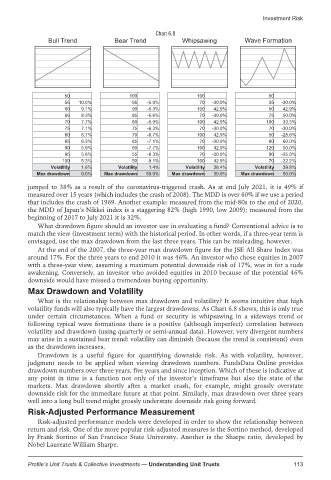Page 115 - Profile's Unit Trusts & Collective Investments - March 2025
P. 115
Investment Risk
Chart 6.8
Bull Trend Bear Trend Whipsawing Wave Formation
50 100 100 50
55 10.0% 95 -5.0% 70 -30.0% 35 -30.0%
60 9.1% 90 -5.3% 100 42.9% 50 42.9%
65 8.3% 85 -5.6% 70 -30.0% 75 50.0%
70 7.7% 80 -5.9% 100 42.9% 100 33.3%
75 7.1% 75 -6.3% 70 -30.0% 70 -30.0%
80 6.7% 70 -6.7% 100 42.9% 50 -28.6%
85 6.3% 65 -7.1% 70 -30.0% 80 60.0%
90 5.9% 60 -7.7% 100 42.9% 120 50.0%
95 5.6% 55 -8.3% 70 -30.0% 90 -25.0%
100 5.3% 50 -9.1% 100 42.9% 70 -22.2%
Volatility 1.6% Volatility 1.4% Volatility 38.4% Volatility 39.8%
Max drawdown 0.0% Max drawdown 50.0% Max drawdown 30.0% Max drawdown 50.0%
jumped to 38% as a result of the coronavirus-triggered crash. As at end July 2021, it is 49% if
measured over 15 years (which includes the crash of 2008). The MDD is over 60% if we use a period
that includes the crash of 1969. Another example: measured from the mid-80s to the end of 2020,
the MDD of Japan’s Nikkei index is a staggering 82% (high 1990, low 2009); measured from the
beginning of 2017 to July 2021 it is 32%.
What drawdown figure should an investor use in evaluating a fund? Conventional advice is to
match the view (investment term) with the historical period. In other words, if a three-year term is
envisaged, use the max drawdown from the last three years. This can be misleading, however.
At the end of the 2007, the three-year max drawdown figure for the JSE All Share Index was
around 17%. For the three years to end 2010 it was 46%. An investor who chose equities in 2007
with a three-year view, assuming a maximum potential downside risk of 17%, was in for a rude
awakening. Conversely, an investor who avoided equities in 2010 because of the potential 46%
downside would have missed a tremendous buying opportunity.
Max Drawdown and Volatility
What is the relationship between max drawdown and volatility? It seems intuitive that high
volatility funds will also typically have the largest drawdowns. As Chart 6.8 shows, this is only true
under certain circumstances. When a fund or security is whipsawing in a sideways trend or
following typical wave formations there is a positive (although imperfect) correlation between
volatility and drawdown (using quarterly or semi-annual data). However, very divergent numbers
may arise in a sustained bear trend: volatility can diminish (because the trend is consistent) even
as the drawdown increases.
Drawdown is a useful figure for quantifying downside risk. As with volatility, however,
judgment needs to be applied when viewing drawdown numbers. FundsData Online provides
drawdown numbers over three years, five years and since inception. Which of these is indicative at
any point in time is a function not only of the investor’s timeframe but also the state of the
markets. Max drawdown shortly after a market crash, for example, might grossly overstate
downside risk for the immediate future at that point. Similarly, max drawdown over three years
well into a long bull trend might grossly understate downside risk going forward.
Risk-Adjusted Performance Measurement
Risk-adjusted performance models were developed in order to show the relationship between
return and risk. One of the more popular risk-adjusted measures is the Sortino method, developed
by Frank Sortino of San Francisco State University. Another is the Sharpe ratio, developed by
Nobel Laureate William Sharpe.
Profile’s Unit Trusts & Collective Investments — Understanding Unit Trusts 113

